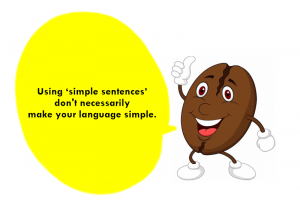My previous blog Developing E-Learning Content for School Kids? Mind Your Language talked about the importance of language in e-Learning content development. As promised there, the next few posts in this series will deal with the cardinal language rules to follow while developing e-Learning content for school kids. These rules indicate the key areas an e-Learning content developer should pay attention to in order to ensure language effectiveness.
Rule 1: Simplicity is the mother of success
You have heard it thousands of times, I am sure, but let me say it once again: keep your language simple. Your learners should be able to understand your language without having to break their heads.
However, it is important to keep in mind that simplicity, in the context of language appropriateness, is somewhat a relative term. The chances of what is simple for one grade or age group turning out to be too complex for another are very high in learning contexts. What is defined as simple will differ from one grade to another depending on the cognitive level and language IQ of learners.
Moreover, if you maintain the same tone and language for the first grade, tenth grade and higher secondary levels, one or more of these groups will either lose interest in the learning content because the language used is very easy, or get distracted in their attempts to make sense of the language. Either way, the effectiveness of your e-Learning content comes under question.
Using ‘simple sentences’ doesn’t make your language simple
 Many people wrongly think that using simple language is equivalent to using simple sentences. You sure have studied your middle school English grammar well; still, let’s take a quick recap of what a simple sentence is.
Many people wrongly think that using simple language is equivalent to using simple sentences. You sure have studied your middle school English grammar well; still, let’s take a quick recap of what a simple sentence is.
To put simply, a simple sentence has only one independent clause and contains a subject and a predicate. Since simple sentences are usually short (which is not always the case as we would soon see), people tend to overuse this sentence type hoping to make their language simple.
However, choosing simple sentences over compound or complex sentences doesn’t always guarantee clarity or intelligibility. For instance, a simple sentence can be very short; it can be very long too. Take a look at the two sentences given
Sentence 1: The man walked slowly.
Sentence 2: The tall and dark-skinned man in white short and black trousers walked slowly towards the garage from under the shadow of the oak tree on the north of the dilapidated house.
Now, as weird as it may sound, both these sentences fall under the category of ‘simple sentences’ if we go by standard grammar textbooks. As seen in the examples given above, it clearly is a mistake to define simple sentences according to their length.
Now, can we define the simplicity of a sentence based on the idea or thought it contains? Read the following sentence:
Example: Social norms make individual liberty an uneasy compromise.
Short. Only 8 words. Simple in structure. But the sentence contains an idea that cries out for many many paragraphs to be explained properly and in clarity.
Remember that, writing effective content is not synonymous with using simple sentences as against complex or compound sentences.
Being simple doesn’t mean being choppy
Another common mistake people make while developing e-Learning modules is to make the content choppy. This happens when you use lots of extremely short sentences, one after the other. You know what I mean? It is almost like breaking a small piece of wood into hundred smaller pieces for no apparent reason. Let me explain it with the help of two examples.
Example 1: Alternatively known as panda bear or simply as panda, the giant panda, a bear native to south central China, is a bamboo-eating animal facing extinction.
Example 2: The giant panda is an animal. It is also known as panda bear. It is also simply called panda. It is a bear. It is native to south central China. It eats bamboo. It is facing extinction.
In example one, excessive information makes the content complex, leading to cognitive as well as linguistic overload. However, in Example 2, excessive use of short, simple sentences makes the content extremely choppy, which in turn adversely impacts the flow of the content. Well, we all respect pronouns, but this clearly is not how we should use them.
Choppy content is as much a distractor as long-winded sentences, especially for learners of higher grades. You cannot develop effective e-Learning content just by using simple sentences and avoiding complex or compound sentences.
How to write effective e-Learning content?
This leaves us with a perplexing question – if using simple sentences alone won’t ensure the quality or effectiveness of your e-Learning content, what constitutes simple language. There are a few factors you should weigh in order to determine whether your language does the job or not.
Measure the language capacities of your target audience
You should have a fairly good understanding of the language capacities of your target audience. Language development happens differently in different individuals, agreed; but there are a few language development milestones humans commonly follow. Learning materials should be developed according to these commonly possessed language skills of an age group. There indeed are exceptions. For instance, the common standards needn’t be followed if you are assessing the language skills per se of learners, or if the content is developed for differently abled learners.
Do content chunking
Do not fill your content with hundreds of simple and extremely short sentences which affect both the flow and the quality of your content, as shown in example 2. Instead, try and break overwhelmingly large chunks of information into logical sequences that hold as a whole when put together. In other words, the ideas and information you try to convey should be manageable to the learner. In e-Learning lingo, this is called ‘Content Chunking’.
Check your content for clarity
The ultimate litmus paper test to check whether your e-Learning content is simple and effective is to see if it has clarity. Check if your language is clear enough to convey the piece of information, concept or idea you are attempting to convey to your target audience. In the context of e-Learning content development, the word “simplicity” is often synonymous with “clarity”. More often than not, clarity is the direct product of simplicity.
Convey the most complex ideas in the simplest way possible
When conveying an idea or concept, use simple sentences and words to write the most complex part of that concept or idea. In other words, complex portions that require the highest degree of clarity should be written in the simplest and most intelligible way. This helps you focus more on the areas that call for clarity of expression. This is one way you can save yourself from falling into the trap of choppy content.
A final word
The effectiveness of your language depends on whether or not you are driving the ideas home, without confusing or overburdening the reader. If your learners are using their energy, which they should be ideally using to comprehend concepts and ideas, to make sense of your language, then your language calls for a revision.







